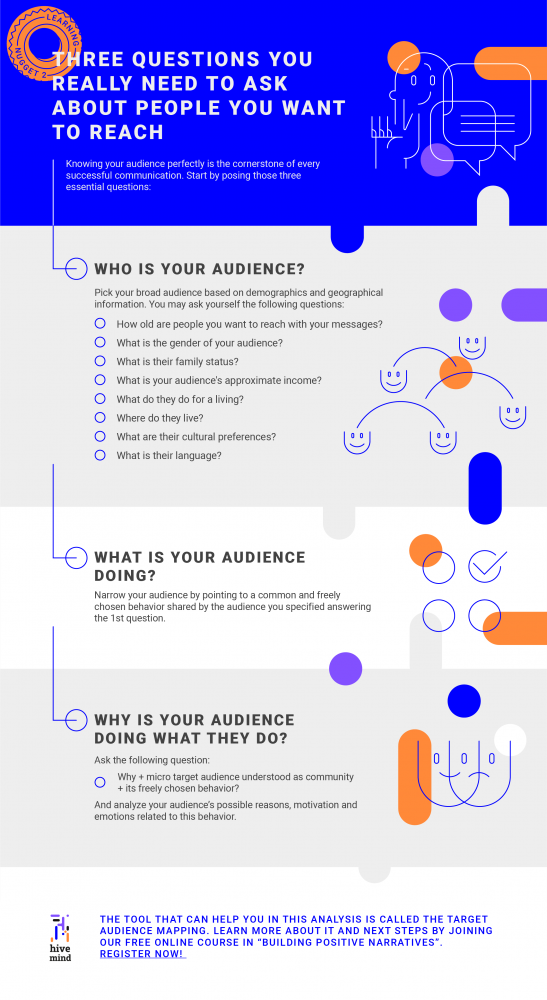Talking to everybody means talking to nobody; we bet you’re already aware of this. As the media are more segmented nowadays, knowing EXACTLY who you are speaking to is pretty essential. So, where to begin?
Who is your audience?
First, pick your broad audience based on demographics and geographical information.
Demographic segmentation means asking questions, like:
How old are people you want to reach with your messages? Do you want to talk to people in a specific age range? How wide is this range?
What is the gender of your audience? Does their gender matter in case of your cause?
What is their family status? Is this characteristic important for your cause?
What is your audience's approximate income?
What do they do for a living? What kind of job do they have?
Geographic segmentation is about asking questions such as:
Where do they live?
What are their cultural preferences? Are there any cultural sensitivities you should take into account planning your communication?
What is their language? Can it be important for them to communicate in other languages than, for example, the official language of the country they live in?
Examples of this broad audience can be: male taxi drivers aged 20-40 living in Poland, Croatian widows with young children, children of Muslim immigrants in Paris speaking both French and Arabic, etc.
After selecting a broad target audience, you should narrow it down to a micro target audience.
The more segmented the audience, the greater the impact your narrative will have, and the more chance it will have of influencing that audience’s behavioural change or views.
What is your audience doing?
To further narrow your audience, point to a community (from the broad audience you specified with demographic and geographical information) that shares the same motivation for its common and freely chosen behaviour you want to have an impact on.
Note that the behaviour should be specific and really chosen by the community. So, for example, in a statement like: “Young men feeling lonely in small towns in the US” “feeling lonely” is not a chosen behaviour, but “staying at home after work” could be.
Other examples: Marihuana smoking teenagers who feel admired by other teenagers. Young women from New York who use a health app and like spending money on sportswear.
So, now you are ready to ask the third question, called "the target question": why does the audience you chose displays this specific behaviour?
Why is your audience doing what they are doing?
The target question should be mappable, meaning it should give you a wide spectrum of topics to analyse, based on which you will recognise your audience’s emotions.
A mappable target question needs to contain both the community and its freely chosen behaviour.
The recipe for a clear target question is as follows:
Why + micro target audience understood as a community + its freely chosen behaviour?
Example: Why do teenage boys start smoking? Why do elderly people in Poland refuse to vote?
With this question, you are ready to use the target audience mapping technique to further develop your knowledge about whom and how exactly you can effectively reach your goals with the campaign you plan.
Join our free online course in “Building Positive Narratives” to be guided through the next steps.
 Like this infographic? You can download it for free here!
Like this infographic? You can download it for free here!
